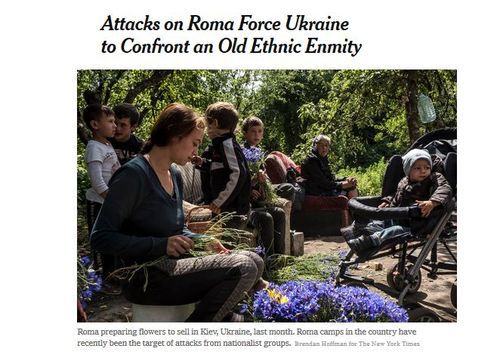


By Steve Sailer
07/22/2018
From The New York Times:
Attacks on Roma Force Ukraine to Confront an Old Ethnic Enmity
By Iuliia Mendel
July 21, 2018KIEV, Ukraine — The Roma who live in tarpaulin camps and abandoned buildings in and around Kiev, the Ukrainian capital, say they make their money harmlessly by picking wildflowers and selling the bouquets to lovers on the city’s streets.
But members of Ukrainian nationalist groups say that, instead, the Roma pick pockets, steal scrap metal and foul the city with their presence, often dressed in rags or hand-me-downs while begging.
Tensions over the Roma are as old as Ukraine, and run as deep here as anywhere in Eastern Europe, but the ancient enmity has taken a twist recently.
Beginning in April, Ukrainian nationalist groups that were given free rein four years ago to fight the Russian military incursion have taken instead to attacking the softer targets of Roma camps, saying they are “cleaning” Ukraine’s cities.
After an attack in April on a camp in Lysa Hora park outside Kiev, when a nationalist group threw rocks, squirted pepper spray and burned down tents, it seemed like an outbreak of the old ethnic scourge, and the episode drew criticism from Western governments and rights groups.
The Ukrainian government seemed to see the assault differently, at least at first. Far from prosecuting the nationalist group, known as C14, which filmed the attack and posted photographs on the internet, the government gave it a state grant in the form of free rent for auditoriums to support “patriotic education.”
No arrests were made immediately after the April attack. Soon enough, five other major assaults ensued, along with dozens of smaller episodes. After one nationalist group, called Sober and Angry Youth, killed a Roma man, David Pap, last month in Lviv, the police detained suspects. Nothing had been done against this group earlier, though it had posted a video online of its members chasing Roma through the city in “A Safari on the Gypsy.”
In July, a court sentenced one participant in the April attack to two months of house arrest.
The attacks pose a dilemma for the Western-backed government in Kiev, which analysts say is seeking populist appeal before presidential elections next spring. The government is beholden to nationalist paramilitaries for their role in the war in the east, even as some of those same groups espouse ugly ideologies.
“We were called fascists,” Yevhen Karas, the 30-year-old leader of C14, said in an interview, referring to the reaction to the attack in Lysa Hora park. But, he added, “I do not care what they call us.” …
After Russia annexed Crimea in 2014, the Roma were early targets during the Russian intervention in the east, with abuses starting on the pro-Russia side. Paramilitaries backed by Moscow rounded them up, saying they were dealing drugs. …
I’ve written lots about Gypsies/Roma before, as well as about Ukraine, Crimea, Russia, and so forth. Instead, I want to mention how this latest phenomenon supports John Mueller’s hypothesis in The Remnants of War (which he should have titled The Dregs of War).

Mueller is the Woody Hayes Professor of National Security Studies at Ohio State. He argues that Kursk-Orel battles between mass armies in open fields are over. If they gave that kind of war, nobody would show up.
His specific examples had to do with the 1990s Balkan Wars, which were portrayed in the press as driven by ancient mass enmities. But Mueller argues that the amount of bloodlust in the overall populations was quite low. The various states had massive problems with draft evasion. Basically, nobody wants to go to a modern battlefield with state of the art weapons because everybody figures they wouldn’t last long in the metalstorm.
So, instead, the Balkan politicians tended to instead recruit to do their low-level fighting already organized groups of men who really like violence: soccer hooligan clubs, prison gangs, far-right nationalist groups, car thieves, motorcycle gangs, and the like. They were let know that they could rape and pillage as long as they did it to the enemy’s civilians.
Eventually, the US deep state trained the Croatian army in the lessons of Operation Desert Storm, and they unleashed Operation Storm in the summer of 1995, with another four day walkover. I presume this was the normal Croatian army, because you aren’t going to hand your tanks to a bunch of criminals. But, in general, a lot of the years of fighting was done by the small minority of men who had already showed they really like hurting other people: hoodlums.
The sputtering fighting in the Russian-speaking parts of Ukraine over the last four years appears to have had similarities to Mueller’s portrait of the Balkan fighting: lumpenproles fighting lumpenproles. Putin swans around with a motorcycle gang and Kiev sends fascist ultras, who sometimes prefer to stay home and punch Gypsies.
The Battle of Stalingrad, it isn’t.
So far.